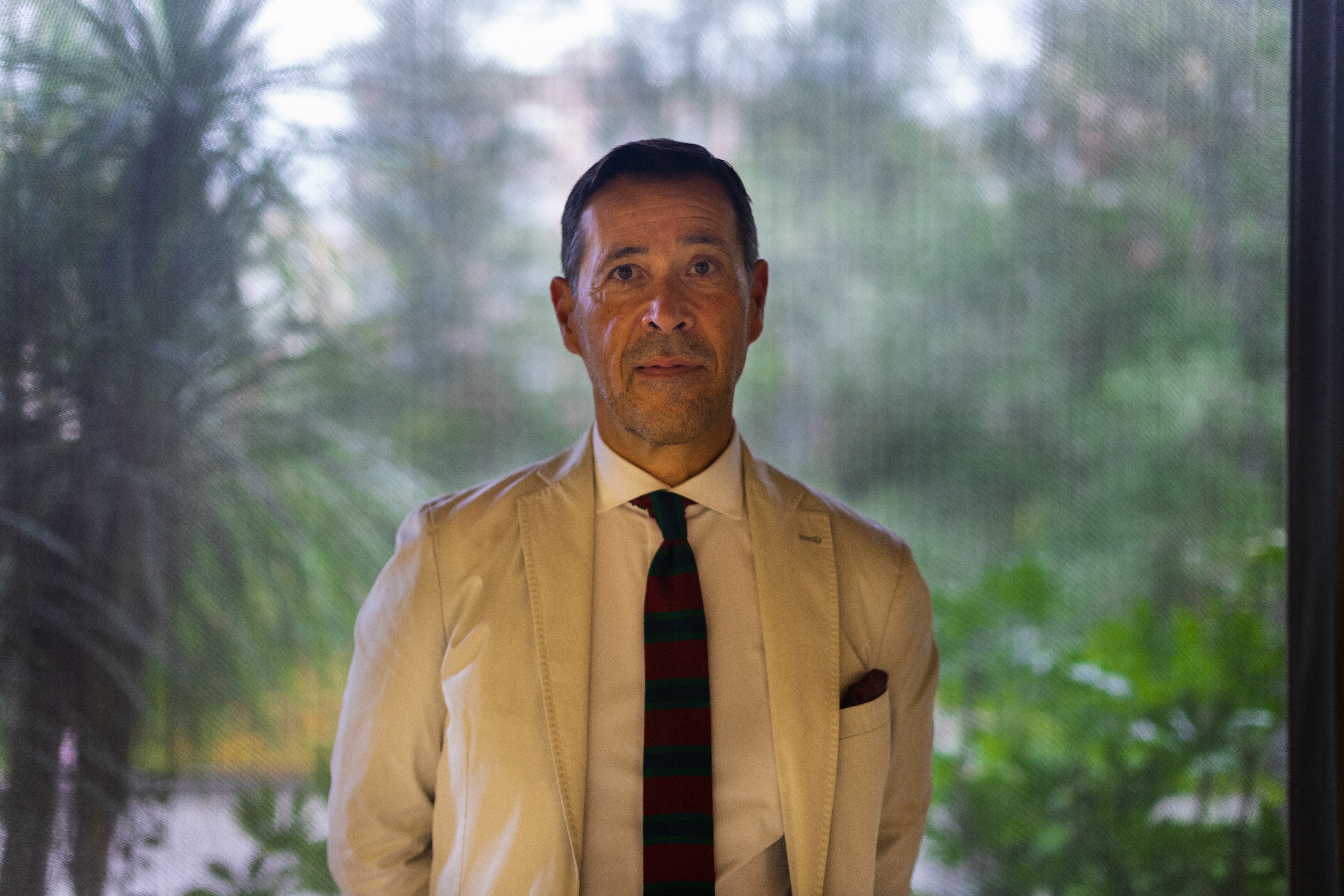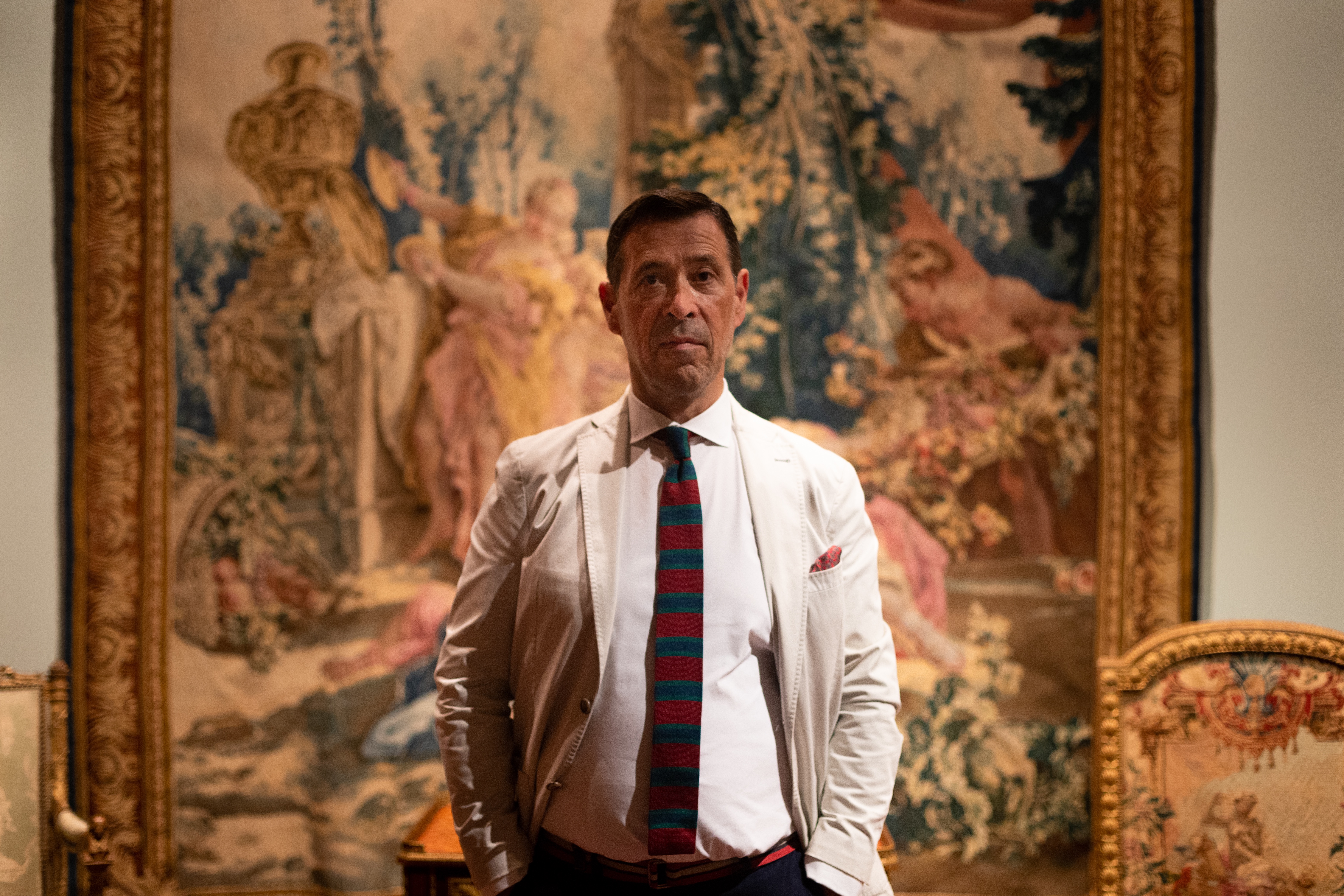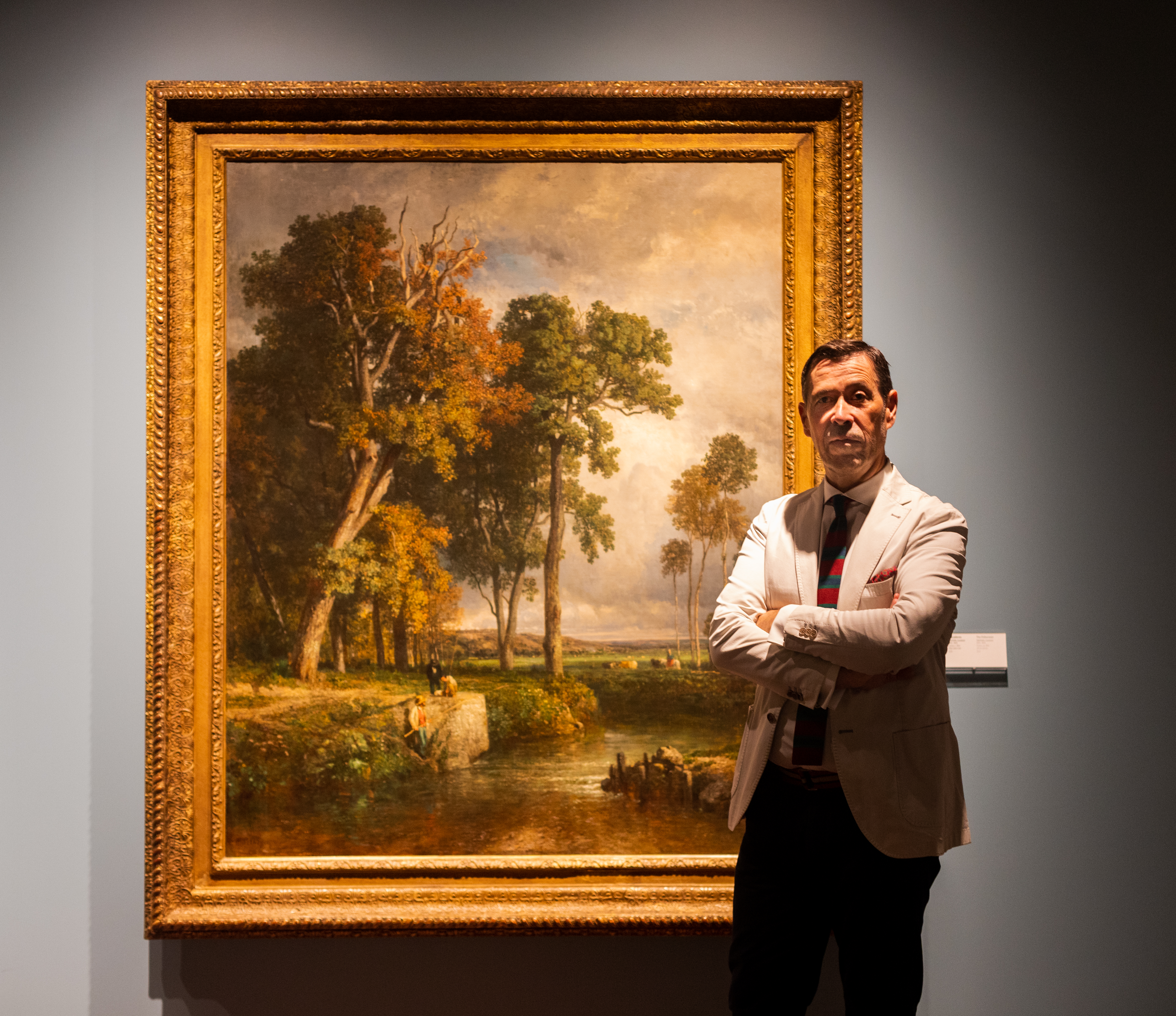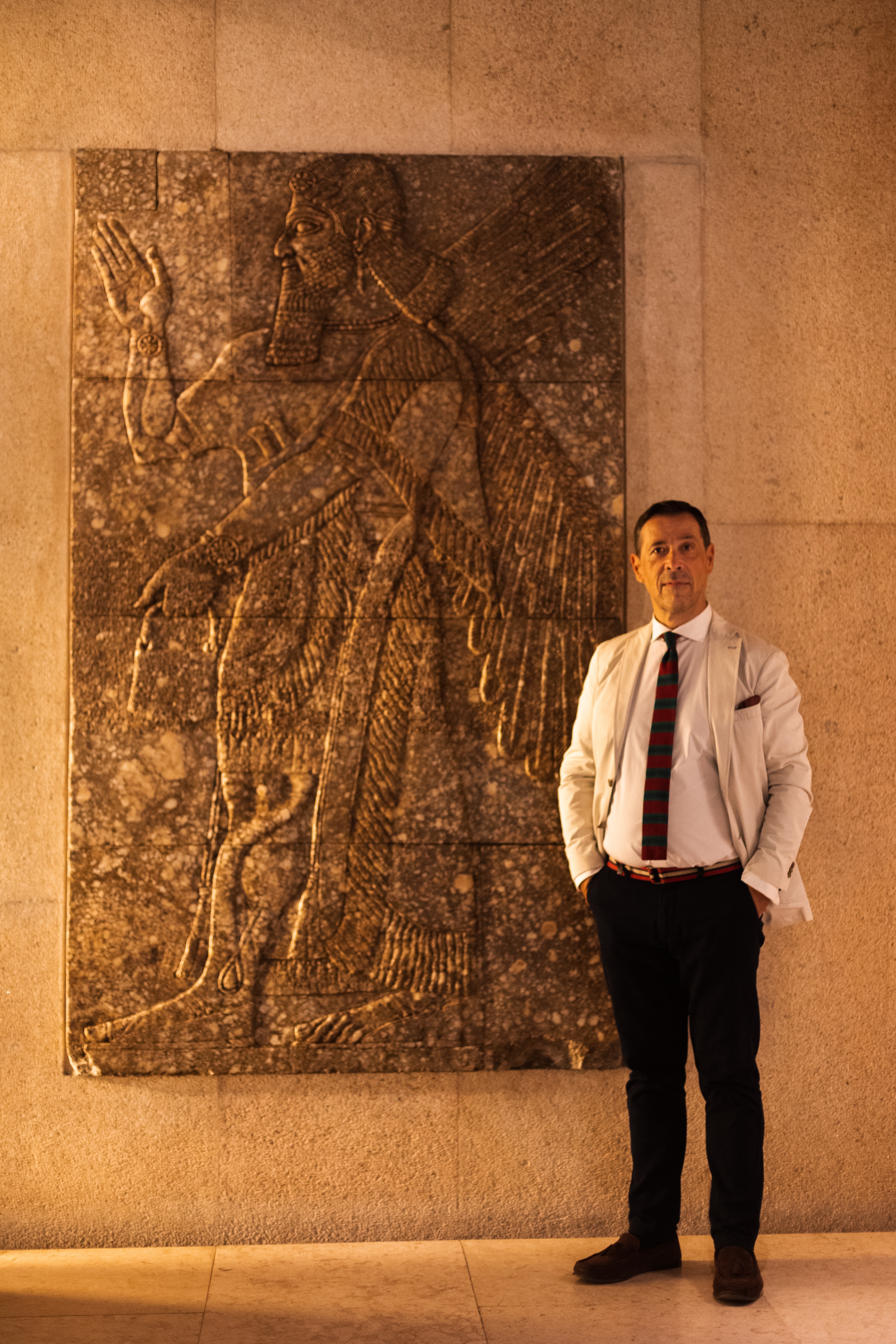FITA Magazine Vol. II / Garden Constellation
António Filipe Pimentel
Interview by Francisco Teles da Gama
![]() Photograph © António Saldanha
Photograph © António Saldanha
The history of the Professor we have before us blends with the history of Portuguese Museology itself. The path he followed takes us to gardens, colleges and, above all, museums of extreme importance in shaping the artistic narrative of Portugal.
At the University of Coimbra, he would finish his degree in History and his Master’s in Cultural and Political History of the Modern Age, with a thesis that was awarded the Gulbenkian Prize for Art History, before he could think that this institution was where his brilliant future would lay. His doctorate followed, where he was able to study the founding of the University of Coimbra, which stands out as one of the oldest in the world. After all this, it is natural to notice that he would take on the positions of Professor, Director of the Art History Institute and Pro-Rector for Heritage at the same university.
Only in 2009 did he abandon his academic career to start working in museums. He began by directing the Museu Nacional Grão Vasco, in the city of Viseu. It was at this decisive moment that he gave a different and more ambitious perspective of museology in Portugal. The following year he headed to Lisbon to become Director of the Museu Nacional de Arte Antiga, one of the oldest and most important museums in the country. In this palace where masterpieces of medieval art up to the 19th century converge, with an immeasurable collection, António Filipe Pimentel would have an open ground to innovate and give due reverence to objects he had researched so much in archives and libraries. Many initiatives became known in these almost ten years of work. The one most people remember is the project Todos Somos Mecenas (We Are All Patrons), where visitors were invited to support the purchase of new masterpieces to integrate the Museum’s collection. Dozens of replicas of paintings were scattered around Lisbon to promote this initiative. The result was a resounding success, showing everyone’s role in building a collection.
One might think from its trajectory that it could not achieve greater prestige. Well, in the Gulbenkian Foundation’s wonderful and enchanting garden, created by the renowned architect Gonçalo Ribeiro Telles, there is a researcher who is in charge of the direction of one of the most magnificent and prestigious museums in the world. The trees and lakes invite various birds to inhabit this paradise, an earthly and unique Dilmun. As soon as we enter the exhibition of the Founder’s Collection, we notice the artifacts from Ancient Egypt and Mesopotamia, unequalled testimonies of the appearance of writing. The Gulbenkian Museum opens its doors to us, come inside and let yourself be guided by the wise words of António Filipe Pimentel.
How did the passion for historical research and museology arise in your life?
Gradually, I believe, and in stages, of course: first was Art History, in the course of undergraduate, master, doctorate... Museology came much later and almost by chance - although as a result -, in the framework of successive museum directorships: the Grão Vasco in 2009, the MNAA from 2010 to 2019, and now the Gulbenkian Museum.
When you entered the university did you think you would become a researcher and a university professor?
When I “entered”, obviously not: I was still very young. But, little by little (and by the very stimulus of the school environment, then led, in Coimbra, by Professor Pedro Dias), the passion for research was installed. Becoming a university professor was a door that opened after graduating and when I was already attending my Master’s degree. Between the two conditions there is a one-year pause...
Which historian most captivated you and made you who you are today?
There were, of course, several (from the cult of rigor in the use of sources, from the so-called “Coimbra school”). However, two names would become references in my understanding of Art History as a “total History”: Jonathan Brown, at the international level, and his study of the Buen Retiro Palace, “A Palace for a King” and, at the national level, José-Augusto França and his “Pombaline Lisbon and the Enlightenment”. I am deeply indebted to both. And to my Master’s in Cultural and Political History, led by Professor Luís Reis Torgal (whose doctoral thesis, on “Political Theory and the Ideology of the State during the Restoration,” also influenced me).
Museums play a key role in disseminating culture and history. How do you see your contribution, as director of one of the best museums in Portugal, to bring Art History closer to the general public?
I usually say that museums play an essential role in democratic societies: to bridge the gap between scientific research and the social community as a whole. Today, a museum is (or should be) a knowledge producing center and research, which it produces or mobilizes in its projects, is a central part of its mission. Even its own communication (and marketing) depends closely on it. They are, truly, para-university institutions, stimulated by the scientific accelerator that represents the very calendar of their programming. In this sense, they have precisely this central mission: to bring art history (in this case, fine arts museums) closer to the general public - thereby demonstrating its “usefulness” for the essential development of critical thinking.
![]() Photograph © António Saldanha
Photograph © António Saldanha
António Filipe Pimentel
The New Director Of The Gulbenkian Museum
Interview by Francisco Teles da Gama
 Photograph © António Saldanha
Photograph © António SaldanhaThe history of the Professor we have before us blends with the history of Portuguese Museology itself. The path he followed takes us to gardens, colleges and, above all, museums of extreme importance in shaping the artistic narrative of Portugal.
At the University of Coimbra, he would finish his degree in History and his Master’s in Cultural and Political History of the Modern Age, with a thesis that was awarded the Gulbenkian Prize for Art History, before he could think that this institution was where his brilliant future would lay. His doctorate followed, where he was able to study the founding of the University of Coimbra, which stands out as one of the oldest in the world. After all this, it is natural to notice that he would take on the positions of Professor, Director of the Art History Institute and Pro-Rector for Heritage at the same university.
Only in 2009 did he abandon his academic career to start working in museums. He began by directing the Museu Nacional Grão Vasco, in the city of Viseu. It was at this decisive moment that he gave a different and more ambitious perspective of museology in Portugal. The following year he headed to Lisbon to become Director of the Museu Nacional de Arte Antiga, one of the oldest and most important museums in the country. In this palace where masterpieces of medieval art up to the 19th century converge, with an immeasurable collection, António Filipe Pimentel would have an open ground to innovate and give due reverence to objects he had researched so much in archives and libraries. Many initiatives became known in these almost ten years of work. The one most people remember is the project Todos Somos Mecenas (We Are All Patrons), where visitors were invited to support the purchase of new masterpieces to integrate the Museum’s collection. Dozens of replicas of paintings were scattered around Lisbon to promote this initiative. The result was a resounding success, showing everyone’s role in building a collection.
One might think from its trajectory that it could not achieve greater prestige. Well, in the Gulbenkian Foundation’s wonderful and enchanting garden, created by the renowned architect Gonçalo Ribeiro Telles, there is a researcher who is in charge of the direction of one of the most magnificent and prestigious museums in the world. The trees and lakes invite various birds to inhabit this paradise, an earthly and unique Dilmun. As soon as we enter the exhibition of the Founder’s Collection, we notice the artifacts from Ancient Egypt and Mesopotamia, unequalled testimonies of the appearance of writing. The Gulbenkian Museum opens its doors to us, come inside and let yourself be guided by the wise words of António Filipe Pimentel.
How did the passion for historical research and museology arise in your life?
Gradually, I believe, and in stages, of course: first was Art History, in the course of undergraduate, master, doctorate... Museology came much later and almost by chance - although as a result -, in the framework of successive museum directorships: the Grão Vasco in 2009, the MNAA from 2010 to 2019, and now the Gulbenkian Museum.
When you entered the university did you think you would become a researcher and a university professor?
When I “entered”, obviously not: I was still very young. But, little by little (and by the very stimulus of the school environment, then led, in Coimbra, by Professor Pedro Dias), the passion for research was installed. Becoming a university professor was a door that opened after graduating and when I was already attending my Master’s degree. Between the two conditions there is a one-year pause...
Which historian most captivated you and made you who you are today?
There were, of course, several (from the cult of rigor in the use of sources, from the so-called “Coimbra school”). However, two names would become references in my understanding of Art History as a “total History”: Jonathan Brown, at the international level, and his study of the Buen Retiro Palace, “A Palace for a King” and, at the national level, José-Augusto França and his “Pombaline Lisbon and the Enlightenment”. I am deeply indebted to both. And to my Master’s in Cultural and Political History, led by Professor Luís Reis Torgal (whose doctoral thesis, on “Political Theory and the Ideology of the State during the Restoration,” also influenced me).
Museums play a key role in disseminating culture and history. How do you see your contribution, as director of one of the best museums in Portugal, to bring Art History closer to the general public?
I usually say that museums play an essential role in democratic societies: to bridge the gap between scientific research and the social community as a whole. Today, a museum is (or should be) a knowledge producing center and research, which it produces or mobilizes in its projects, is a central part of its mission. Even its own communication (and marketing) depends closely on it. They are, truly, para-university institutions, stimulated by the scientific accelerator that represents the very calendar of their programming. In this sense, they have precisely this central mission: to bring art history (in this case, fine arts museums) closer to the general public - thereby demonstrating its “usefulness” for the essential development of critical thinking.
 Photograph © António Saldanha
Photograph © António Saldanha
The Gulbenkian Museum’s collection is
vast and transversal. How can this monumental collection help us understand the
importance of Art as an agent of change?
Precisely because of its very scale, universality, and disciplinary transversality, it meets the ideal conditions for (through the continuous production of new knowledge about it) the (eloquent) demonstration of the importance of Art as an agent of change.
Both at the National Museum of Ancient Art and now at the Gulbenkian Museum you are surrounded by a garden. Nature is the ideal setting for the great artistic and historical masterpieces?
Calouste Sarkis Gulbenkian had a clear vision of the importance of the connection between Man and Nature. It was, one might say, almost an obsession with him, which he personally tried to materialize in the gigantic investment made, for decades, in his estate “Les Enclos”, in Normandy. As Cristina Castel-Branco recently wrote, Gulbenkian Foundation’s garden is the true materialization of his own aspirations - including the fascinating way it interrelates with the headquarters building and the Museum. In turn, the MNAA cannot be dissociated from its wonderful garden, suspended over the Tagus, one of the last survivors of the connection that once existed between the riverside palaces and the great waterway: its public can tell you that? The fact that Lisbon’s two great museums have, in their DNA, a connection to their gardens is, I think, the best answer to the question: Calouste Gulbenkian obviously understood that.
![]()
Photograph © António Saldanha
Which artist do you most admire in the Gulbenkian Museum’s collection?
It is a very difficult question to answer... Perhaps I could answer it, with a bleeding heart, for the number of names omitted: but not to evade the “game” of choosing just one: Rembrandt. The “Figure of an Old Man” (personally I like to think of it more as “Portrait of an Old Man”) is really an amazing work! It is worth coming to Lisbon just to see it. It sums up, in itself, the entire work of the painter.
Does this artist have any representation of nature that fascinates you?
Rembrandt’s painting almost ignores nature and landscape. When I directed the MNAA, which has a beautiful small drawing of his with that theme, we welcomed, in late 2017, a very rare representation of the theme, on loan from the Rijksmuseum in Amsterdam: also a tiny painting. Obviously, in the exhibition, it figured side by side with the drawing from the national collections. But this rarity of the representation of nature (in the common sense) in the work of the painter, whose play of light is not compatible with the painting that, later, would be called “open air”, is like the demonstration of being entirely absorbed in his own illustrative obsession: that of human nature.
![]()
Photograph © António Saldanha
Since the Gulbenkian is a place where culture is expressed in all forms, from dance to music, how do you see yourself going from being an assiduous visitor of this artistic temple to the director of its Museum?
As someone who (to the best of his abilities) seeks and will seek to give his best, in his particular sphere of action, so that the Foundation, as a whole, will be what is rightly stated here: a true temple of the arts; like an oasis where, in Lisbon, one can enjoy the best of all disciplines, in that holistic vision that illuminated Calouste Gulbenkian when he envisioned the Foundation itself.
The interview to António Filipe Pimentel was published on pages 18 to 22 in the Gulbenkian Garden chapter of FITA Magazine Vol. II / Garden Constellation dedicated to the city of Lisbon.
Precisely because of its very scale, universality, and disciplinary transversality, it meets the ideal conditions for (through the continuous production of new knowledge about it) the (eloquent) demonstration of the importance of Art as an agent of change.
Both at the National Museum of Ancient Art and now at the Gulbenkian Museum you are surrounded by a garden. Nature is the ideal setting for the great artistic and historical masterpieces?
Calouste Sarkis Gulbenkian had a clear vision of the importance of the connection between Man and Nature. It was, one might say, almost an obsession with him, which he personally tried to materialize in the gigantic investment made, for decades, in his estate “Les Enclos”, in Normandy. As Cristina Castel-Branco recently wrote, Gulbenkian Foundation’s garden is the true materialization of his own aspirations - including the fascinating way it interrelates with the headquarters building and the Museum. In turn, the MNAA cannot be dissociated from its wonderful garden, suspended over the Tagus, one of the last survivors of the connection that once existed between the riverside palaces and the great waterway: its public can tell you that? The fact that Lisbon’s two great museums have, in their DNA, a connection to their gardens is, I think, the best answer to the question: Calouste Gulbenkian obviously understood that.

Photograph © António Saldanha
Which artist do you most admire in the Gulbenkian Museum’s collection?
It is a very difficult question to answer... Perhaps I could answer it, with a bleeding heart, for the number of names omitted: but not to evade the “game” of choosing just one: Rembrandt. The “Figure of an Old Man” (personally I like to think of it more as “Portrait of an Old Man”) is really an amazing work! It is worth coming to Lisbon just to see it. It sums up, in itself, the entire work of the painter.
Does this artist have any representation of nature that fascinates you?
Rembrandt’s painting almost ignores nature and landscape. When I directed the MNAA, which has a beautiful small drawing of his with that theme, we welcomed, in late 2017, a very rare representation of the theme, on loan from the Rijksmuseum in Amsterdam: also a tiny painting. Obviously, in the exhibition, it figured side by side with the drawing from the national collections. But this rarity of the representation of nature (in the common sense) in the work of the painter, whose play of light is not compatible with the painting that, later, would be called “open air”, is like the demonstration of being entirely absorbed in his own illustrative obsession: that of human nature.

Photograph © António Saldanha
Since the Gulbenkian is a place where culture is expressed in all forms, from dance to music, how do you see yourself going from being an assiduous visitor of this artistic temple to the director of its Museum?
As someone who (to the best of his abilities) seeks and will seek to give his best, in his particular sphere of action, so that the Foundation, as a whole, will be what is rightly stated here: a true temple of the arts; like an oasis where, in Lisbon, one can enjoy the best of all disciplines, in that holistic vision that illuminated Calouste Gulbenkian when he envisioned the Foundation itself.
The interview to António Filipe Pimentel was published on pages 18 to 22 in the Gulbenkian Garden chapter of FITA Magazine Vol. II / Garden Constellation dedicated to the city of Lisbon.

